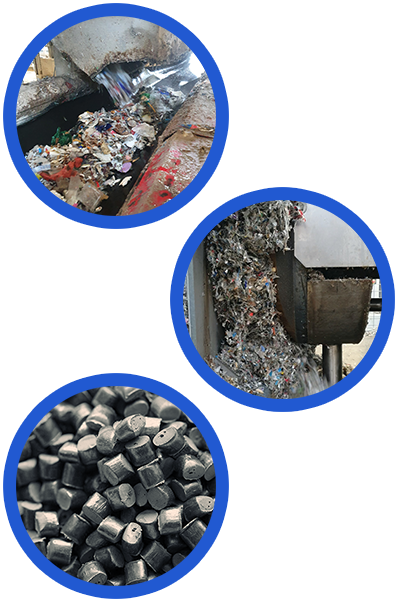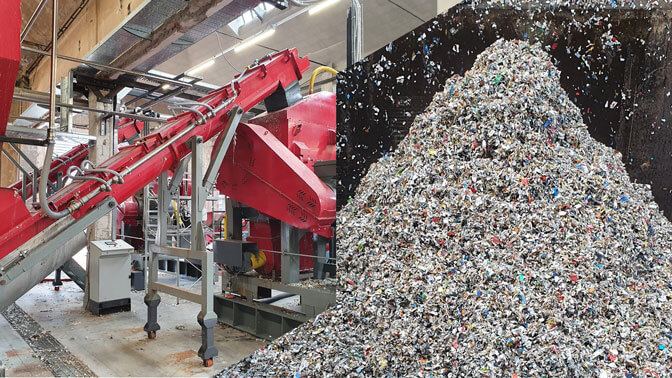Advantages
Paper Fiber
Recovering
It flows back to the
paper mill process.
Metal and Plastics
Recycling
By reducing
the pollution.
Money
Saving
Elevated ROI.
TAX Incentives.
The process
- Water and paper fiber are returned to the paper mill process;
- Clean metals are intended for sale;
- The plastics undergo further processing, separating the heavy fraction (PVC) from the light fraction (PE – PP);
- Finally, the latter is drawn to obtain a quality granule intended for the injection molding market.

Industry 4.0
In addition, the IIoT (Industrial Internet of Things) allows predictive maintenance, reducing downtime, and the possibility of remote assistance.
All in one
The Paper Pulp waste recycling plant is complete, because it allows you to separate and extract up to 90% of the raw materials contained in the residue of the waste paper recycling process.
This allows you to significantly save on disposal costs, which are constantly increasing.
The plant does not require special authorizations, as the process is completely mechanical, without the use of chemical agents

Circular Economy
La soluzione ZWP di trattamento del residuo Pulper permette il riciclo delle materie prime rispondendo in pieno ai principi di economia circolare.
La cartiera può accedere agli incentivi, sia italiani sia europei, utilizzando gli innumerevoli vantaggi economici e fiscali, come il credito a fondo perduto del PNRR dal 35% al 55% dei costi.
End of Waste
End of Pulper
If we want to contribute to the protection of the environment, each of us has a moral obligation to reduce the amount of waste produced.
Hydroswiss’s End of Pulper plant goes in the direction of the broader philosophy of the End of Waste, which was the production of industrial waste destined for landfill or disposal.
No Plastic Islands
According to a Greenpeace report, most of European plastic waste is exported outside the EU and part of it transits illegally, with serious social and environmental consequences.
Therefore we should recycle our waste to truly be an environmentally advanced society.
Our plant is a step towards a more sustainable future.

No pastic tax
We recycle
and separate
The usual EWC code referring to waste pulper is 03 03 07, but since the plant is conceived as a natural continuation of the waste paper process, EWC 15 01 01.
All materials leaving the treatment plant are classified with the following codes:
- EWC 15 01 02 plastic packaging;
- EWC 15 01 04 metal packaging.
The PE PP light plastics separated from waste pulper are transformed into secondary raw material in the form of granules.
Brief presentation
Contact us for more information
Do you want to start saving now?
Start by filling in the fields on the side!
You will be contacted by our experts who will clarify any doubts.
Would you like to support the project?
Find out how you can do this
FAQ
Is the plant for big paper mills only?
The cost-benefit ratio becomes interesting starting from 5,000 tons of waste per year.
For smaller productions we are evaluating alternative solutions.
Are there any incentives for this type of plant?
There are many incentives referred at Industry 4.0 and Circular Economy in many countries.
Do you need special authorizations to install this plant?
No. The plant is framed as a natural continuation of the existing plant in the paper mill process and therefore a normal authorization is needed.
Does the process use chemicals?
No. The system is powered only with process water from the paper mill and returned to the paper mill after use. Furthermore, chemicals are difficult to manage and often dangerous for the environment.
Is it possible to integrate machinery already present in the paper mill?
Yes. If the existing machinery is functional to our plant, it is possible to integrate them into the process, saving on the supply.
Rent or Buy?
There is the possibility of both purchase and operational rental.
Can the paper fiber recovered from washing be recycled?
Yes. The process water is used to wash all the waste in the various stages of treatment and the paper fiber is “captured” by the water and returned to the paper mill to be used again in the pulper.
Do you need a lot of space to house the plant?
No. Being a modular system it is almost always possible to find a layout solution that meets the customer’s needs.
Do you need highly qualified personnel to run the plant?
No. Hydroswisstakes care of staff training but, if necessary, it can also take charge of running the plant
With which EWC codes are the materials leaving the plant considered?
The sinking part of the tanks is considered EWC 03.03.07 waste. While the parts leaving the treatment are considered EWC 15.01.02 plastics, and EWC 150104 metal ones. Finally, in the process we have plastic granules considered secondary raw material
Are the plants imported from China?
No. The machines are designed in Italy and produced in Europe.

